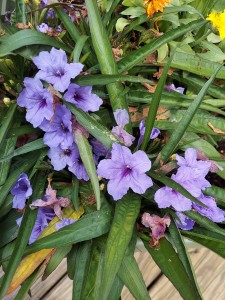 My daughter loves a new plant—especially a tropical plant. Because of her I grow rambunctious cannas, lovely plumbago, ornamental ginger and tropical hibiscus. Now we have added a new member to the domestic plant family—Mexican petunia, known variously as Ruellia brittoniana, Ruellia simplex, Ruellia tweediana and Ruellia spectabilis. That is a lot of Latin names for one plant. It has even more common names, including desert petunia, Mexican blue bells, and Florida bluebells.
My daughter loves a new plant—especially a tropical plant. Because of her I grow rambunctious cannas, lovely plumbago, ornamental ginger and tropical hibiscus. Now we have added a new member to the domestic plant family—Mexican petunia, known variously as Ruellia brittoniana, Ruellia simplex, Ruellia tweediana and Ruellia spectabilis. That is a lot of Latin names for one plant. It has even more common names, including desert petunia, Mexican blue bells, and Florida bluebells.
If truth in advertising applied to plants, ruellia would be done for. It is neither a bluebell nor a petunia. In fact, ruellia is a member of the large acanthus or Acanthaceae family, which contains about 250 genera, including the tall, bear’s breeches that many of us raise in our home gardens. The “petunia” comes from the appearance of the flowers, which are fused at the bases and flare out into five-petaled trumpets, just like members of the popular petunia clan.
Despite the “petunia” misnomer, Mexican petunia and its ruellia relatives are truly native to Mexico, the Caribbean, Central America, South America and the southern United States. They are evergreen in regions with warm and mostly warm winters, USDA plant hardiness zones 8B through 11. Some sources venture that Ruellia simplex might even be hardy in USDA plant hardiness zone 7, though it would probably need a protected location, lots of mulch and lots of luck. I live in Zone 7 and intend to grow my plant as an indoor specimen during the late fall and winter.
Mexican petunia was first described in Cuba in 1870 and christened “Ruellia simplex”. Many sources use that name now. Others prefer “Ruellia brittoniana”, which honors Nathaniel Lord Britton, the late nineteenth and early twentieth century botanist who founded the New York Botanical Garden. The species form is the ancestor of the plants we buy now. The various cultivated varieties on the market have been bred from the species, with an emphasis on better color, increased hardiness and good reproductive manners. Species ruellia and some varieties tend to spread to the point of invasiveness in warm weather areas like Florida. Many of their modern descendants are either sterile or much less prolific.
Our new Mexican petunia is a dwarf variety called ‘Katie’s Blue’, and its vivid blue-purple flowers remind me of small traditional petunias with a bit more substance in the petals. The difference between a “real” petunia and a Mexican petunia is also apparent in the leaves. Petunia leaves are soft and rounded, almost sticky to the touch. Medium to dark green Mexican petunia leaves are long and lance-shaped, making the dwarf varieties effective as ground covers and container subjects.
‘Katie’s Blue’ is one of the “Katie” series of dwarf plants that also includes ‘White Katie’ and ‘Katie’s Pink’, which features pink-purple trumpet blooms. The ‘Southern Star’ series is another group of dwarf plants in similar colors, as is the ‘Mayan’ series, developed at the University of Florida. Little ‘Strawberries and Cream’, discovered in 1994, also features variegated foliage that is speckled with white and blushes pink in the sun. Non-dwarf varieties grow one to three feet tall. Dwarf types top out at less than one foot.
Among the available standard size varieties is ‘Chi Chi’, which grows 24 inches tall and bears pink flowers. ‘Purple Showers’ rises between 36 to 48 inches, as does another purple-flowered variety, ‘Machu Morado’. Neither self-seeds, but spreads by underground rhizomes in warm weather areas.
The color range of ruellia is limited to white, pink, blue-purple and purple, but those colors generally blend with a wide range of more assertive garden hues.
In the last few years Mexican petunia has become more available from nurseries and garden centers on the East Coast. The plants have long been commonplace elsewhere. If you can’t find one locally, try Almost Eden Nursery, 1240 Smith Rd, Merryville LA 70653; (337) 375-2114; www.almostedenplants.com.
